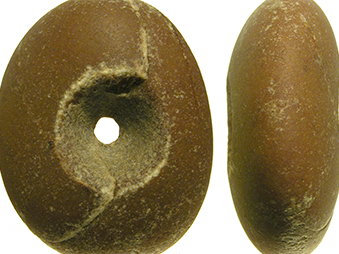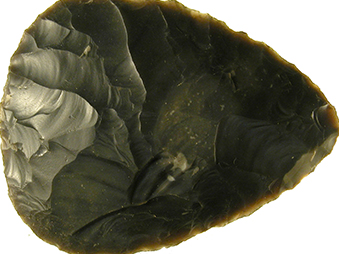The Palaeolithic in Britain is a vast period spanning over 800,000 years, from the earliest occupation at Happisburgh in Norfolk more than 850,00 years ago and Pakefield in Suffolk approx.700-500,00 years ago, to the end of the most recent glacial period c.12,000 years ago. The period featured many glacial cycles with fluctuating temperatures and environments, which varied from arctic, sub-arctic, temperate forested to steppic. Britain was at times either an island or peninsula connecting to mainland Europe depending on changing sea levels. Fauna varied greatly but there is evidence for large mammals such as mammoth, elephant, hyaena, reindeer as well as predators such as cave bear and lion. Various human species and technologies were present at different times.
Archaeologists use Marine Isotope Stages (MIS) as the chronological framework to describe glacial cycles as well as years ago BP (before present). More recent Upper Palaeolithic divisions are often described using years BC. The Palaeolithic period in Britain covers from c. MIS 19 to MIS 2.
Click on the headings below to find out more.
The Lower Palaeolithic in Britain is the earliest period from c.700,000 to 325,000 years ago (MIS19-MIS9) and is characterised by pre-Levallois (prepared flint core) technologies. The Lower Palaeolithic in Britain is usually ascribed to human species pre-Neanderthal Homos antecessor and heidelbergensis.
The flint tool technologies of this period are flake-based Clactonian and Handaxe-based Acheulean.
The map below shows the distribution of Lower Palaeolithic finds across Suffolk, with a concentration in the Breckland region. There is a noticeable absence of finds in the mid-north east and south west of the county between river valleys. This may be due to the thick glacial clays/till covering these areas.
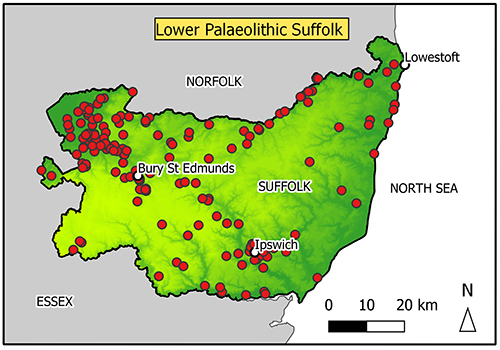
Image: Sites and findspots in Suffolk dates from between Lower Palaeolithic Suffolk c.700,000-325,000 Years Ago.;
The Bytham River and Pre-Anglian Suffolk
The extinct Bytham River flowed eastwards from the West Midlands, through East Anglia and into the North Sea and deposited quartz and quartzite-rich gravels, which now survive only as remnants on the sides and tops of the low-lying hills. These gravels are arranged in a series of river terraces, which were formed as the river cut successively lower courses, resulting in preservation of former floodplain sediments, which increase in age with altitude. This river was destroyed by the Anglian Glaciation 450,000 years ago.
The Bytham gravels have survived in patches, remnants of a series of terraces that chart the evolution and migration of the river through successive glacial-interglacial cycles.
Important sites occupied by ancient humans associated with Bytham River deposits in the Breckland area are Warren Hill (MNL 001), Maidscross Hill (LKH 036), High Lodge, (MNL 002) and Pakefield Cliffs (GSE 061). Pakefield has the oldest tools found in Suffolk and the second oldest tools found in Britain.
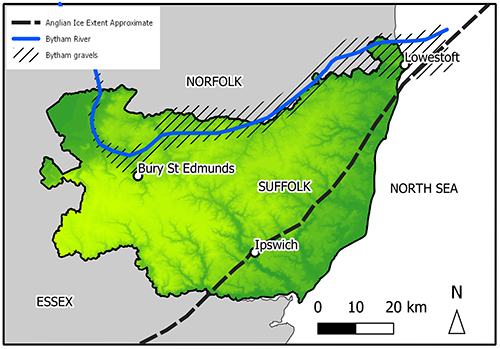
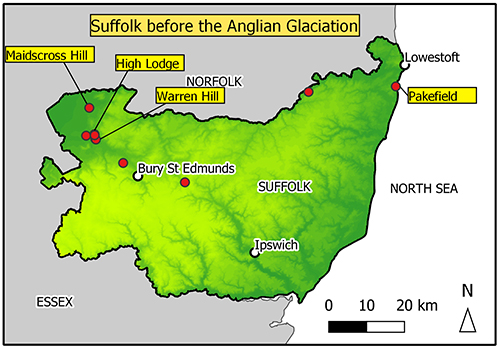
Image (left): The Bytham River in Suffolk before the Anglian Glaciation in MIS 13 (c. 500,000 years ago). The black line and hashed area are the likely locations of the main river channel and gravels (after Rose 2009). Image (right): Sites in Suffolk dated before the Anglian Glaciation in MIS 13 (c. 500,000 years ago).
MIS11 c.424-374,000 years ago
Suffolk has many key sites from MIS11, also known as the Hoxnian Interglacial. MIS11 is a warm period which follows immediately after the Anglian Glaciation. The climate was approximately like it is today.
The archaeological record of the Hoxnian consists of two stone tool assemblage types. One type lacks handaxes and is termed ‘Clactonian’ after the type-site at Clacton, Essex. The other type has handaxes and therefore assigned to the Acheulean. The relationship between these two assemblages has long been a subject of debate.
Key sites include East Farm Barnham (BNH 013), Foxhall Road, Ipswich (IPS 056), Hoxne, (HXN 001, for which the Hoxnian interglacial is named), Elveden Brick pit (ELV 006) and Beeches Pit, West Stow (WSW 009) which has evidence of fire use.
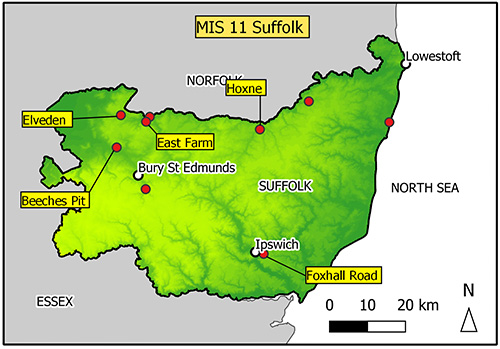
Image: Sites in Suffolk with finds from MIS11.
The Middle Palaeolithic in Britain spans from c.325,000 to 44,000 years ago (c. MIS9-MIS3). The period is subdivided neatly into an Early and Late period separated by a long occupation hiatus of c. 120,000 years, when the region was uninhabited by Neandertals between MIS6 and the end of MIS4 (c. 180,000-60,000 years ago). This is likely the result of a harsh cold climate followed by Britain’s change from a peninsula of North-West Europe to an island during MIS5e (c. 128,000-116,000 years ago) but the exact reasons are uncertain. There is some academic debate over evidence recolonisation during c. MIS 5d-5B (c. 109,000-87,000 years ago), however the evidence is limited. Unsurprisingly, the archaeological evidence before and after this long absence of occupation is quite different. During the Early Middle Palaeolithic there was significant use of Levallois core technology, whereas in the later Middle Palaeolithic biface/handaxe flint tool technology are predominant. Exactly how this reflects different technological interactions with the environment is uncertain.
Early Middle Palaeolithic c.325,000 – 180,000 years ago
The Early Middle Palaeolithic period in Britain spans from c.325,000 to 180,000 years ago (c. MIS9-MIS7). Suffolk is less densely populated during this period compared to the Lower Palaeolithic. The landscape was likely covered by a mix of grassland and woodland, demonstrated at sites such as Stoke Bone Bed (IPS 072, IPS 163) and Jordan’s Pit. (BCB 002).
The tool technology during this period is characterised by the use of Levallois flake core technology. Whilst Levallois is associated with Homo neanderthalensis (Neandertals), there is some debate as to whether they should be considered pre -Neanderthals., separate from later “Classic” Neanderthals, c MIS5-MIS3.
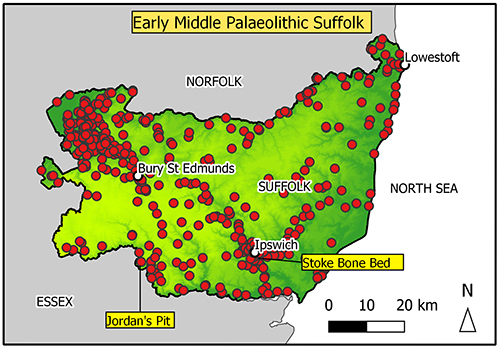
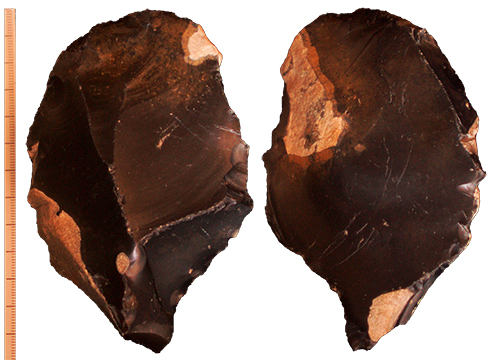
Image (left): Early Middle Palaeolithic Findspots in Suffolk. Image (right): Levallois Core from Aldebugh, ©Winchester Museums Service. HER record ADB 269
MIS 5e c. 128-116,000 years ago
MIS 5e c.128-116, also known as the “Ipswichian” Interglacial, was a warm period when Britain was an Island separated from Europe. Hominin (Neanderthal) populations appear entirely absent from Northwest Europe at this time.
The interglacial was one of the warmest for the last half million years. Pollen records suggest a dense deciduous forest with a fauna including straight tusked elephant, wild boar, aurochs (wild cattle) and Hippopotamus.
Important sites within Suffolk include the Ipswich Type-Site at Bobbitshole (WHR 038) near Ipswich and pits at Newmarket and Lavenham, (LVM 014).
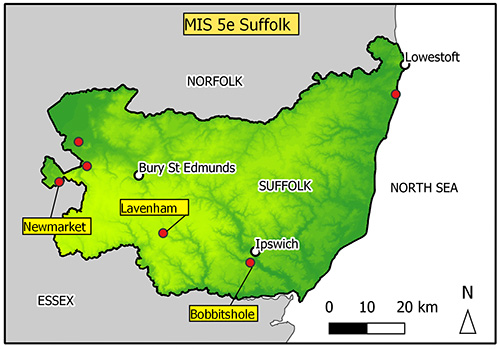
Image: Sites in Suffolk with (faunal) finds from MIS 5e.
Late Middle Palaeolithic c. 60,000 – 45,000 years ago
The Late Middle Palaeolithic period in Britain spans from c.60,000 – 45,000 years ago (Late MIS 4-MIS3). Britain was the western upland area at the edge of the Doggerland plain during MIS3 (c. 57,000-29,000 years ago). This would have been the western extent of an open-steppic environment generally referred to as “Mammoth Steppe” and would have stretched from Britain to North America. It was characterised by rich grassland with patches of marsh, acid heath and bare sandy ground. Ice cores show the climate was characterised by millennial length warm/cold climatic oscillations. Local climate reconstructions using beetles from soil samples suggest that a warm oscillation would have seen cool (c. 10°C), short summers with long harsh winters (c -20°C) Neanderthal occupation was likely characterised by brief hunting excursions following large mammal herds in the summer months in warm events only.
Biface/handaxes were the predominant flint tool type in this period, likely related to the Mousterian of Acheulean Tradition technocomplex used by Neanderthals in Europe. The Levallois core technology of the earlier period was rarely used. It is different from contemporary Neandertal occupation in both Northern and Southern Europe and is characterised by a small number of briefly occupied caves in the West of Britain. In South Eastern Britain, including Suffolk, it is almost exclusively represented by singular discoveries of a specific MIS3 constrained artefact type: the so-called Bout Coupé handaxe.
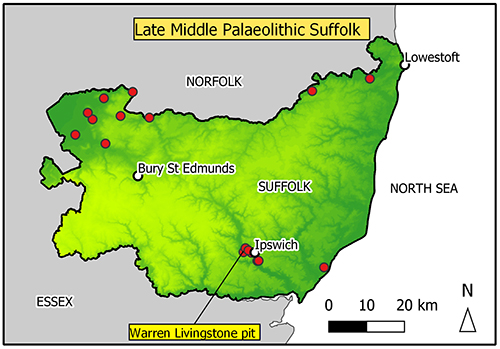
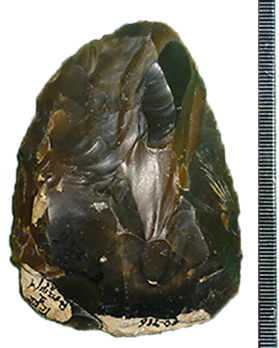
Image (left): Late Middle Palaeolithic Findspots in Suffolk.
Image (right): Late Middle Palaeolithic Handaxe, sometimes referred to as “Bout Coupé” or Flat Butted cordate. After Cutler 2013, © Colchester and Ipswich Museums
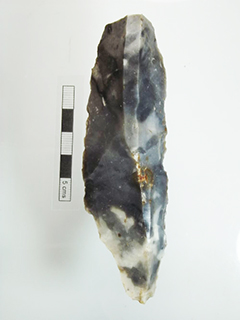
The Upper Palaeolithic period spans from c. 44,000 to 10,000 years ago, (MIS3-MIS2). It describes the period from the final Neanderthals and various Modern-Human made technocomplexes to the end of the last glacial period from mid MIS3 to the end of MIS2.
There was widespread use of blade-based technologies and bone, antler and ivory artefacts. There was also advances in art and jewellery across Britain, although there is no evidence for this in Suffolk, possibly due to poor preservation or maybe due to reduced occupation.
There is limited evidence for Upper Palaeolithic material prior to the Last Glacial Maximum in MIS2 when an ice sheet reached as far as the North Norfolk Coast. Some lithic technologies such as the Aurignacian, which is associated with the first modern human Populations c. 40,000-34,000 years ago, are entirely absent or unidentified in Suffolk.
However, after the Last Glaciation there appears a greater number of finds from later periods of the Late, Final and Terminal Palaeolithic (12,700-9,400BC).
Image: A flint blade of Upper Palaeolithic age from Flixton. © Norfolk County Council, HER record FLN 070
The Earliest Upper Palaeolithic (LRJ), c. 44,300-42,500 years ago
The Leaf-Point-defined LRJ (Lincombian-Ranisian-Jerzmanowician technocomplex) is found in the Northern European Plain during MIS3 from Poland to Wales. These leaf points mostly lack stratigraphic context and often occur as single finds.
The type-fossils take two similar forms of leaf shaped flint tools: bifacially worked “fully bifacial leaf points” and “blade leaf points”. In Suffolk, evidence for settlement is mostly represented by finds of leaf points of both types of which blade leaf points are more common.
The LRJ was originally linked with later Solutrean and Aurignacian industries and thus made by Modern humans, however this is no longer a plausible theory. LRJ is now generally considered to be an earlier final Neandertal-made industry. Thus, the LRJ is not linked to acculturation processes but instead to an evolution from Late Middle Palaeolithic industries from Northern and Central Europe perhaps as response to a specific suite of hunting requirements in the mega-fauna populated cool-steppic environment present at the time.
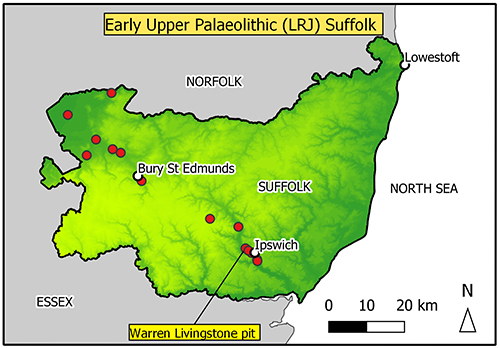
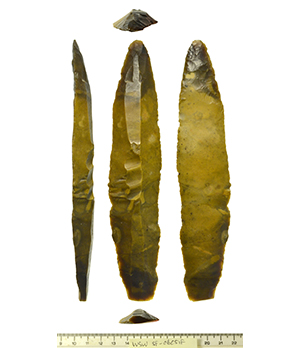
Image (left): LRJ Palaeolithic Findspots in Suffolk. Image (right): A Blade Point from West Stow, HER record WSW 139
The Gravettian c. 34,000 – 33,000 years ago
The Gravettian occupation in Britain was likely brief during short climatic ameliorations. Finds are dispersed across Southern Britain and it is likely that Gravettian populations roamed widely hunting large mammals across steppic environment. However, there is little evidence for occupation in Suffolk or East Anglia.
In Wales, the so-called Red-Lady burial at Paviland indicates the existence of more complex remains. Elsewhere, the presence of Gravettian populations is based on the recovery of diagnostic tanged flint Font Robert points, which are flint tools with a tanged point and leaf‐shaped blade of plano‐convex section. Two of these Font Robert points have been are found in Suffolk; one from the Mildenhall area although its identification is uncertain; and the other was recovered from a gravel quarry by suction pump in the 1920s and 1930s at the Warren Livingstone Pit (IPS 018) in Ipswich.
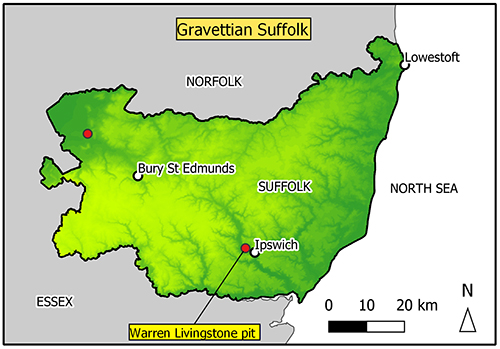
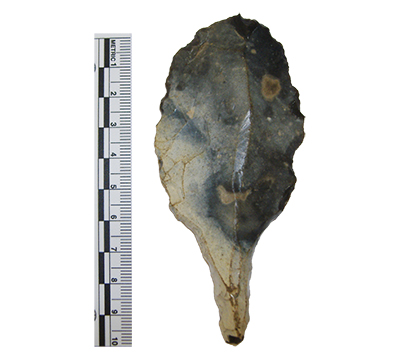
Image (left): Gravettian Findspots in Suffolk. Image: (right) A Gravettian Font Robert point
Late Upper Palaeolithic c. 12,700-12,100BC
Late Upper Palaeolithic spans from c.12,700 to 12,100BC and is a term often given to the entire post-glacial Upper Palaeolithic to the beginning of the Mesolithic. It also refers to the initial recolonization during a period of warmer temperatures, known as the Meiendorf period of the Late Glacial Interstadial. The Later Upper Palaeolithic is also referred to as the Creswellian, which Is named after Creswell Crags in Derbyshire; elsewhere in Europe it is also known as the Final Magdalenian.
Final Magdalenian flint assemblages are characterised by blade cores worked preferentially from a single striking platform using soft hammer percussion with an antler or animal bone. The classic diagnostic retouched forms associated with these assemblages are angle-backed pieces known as ‘Cheddar’ and ‘Creswell’ type points.
The landscapes of southern Britain were dominated by herb-rich grasslands, perhaps with some juniper scrub and stands of birch trees. Communities were generally mobile and dependant on the hunting of large herbivores, predominantly horse but also red deer, aurochs and possibly reindeer. Final Magdalenian groups had large territories, likely incorporating areas of the now submerged landscapes of Doggerland.
The map below shows the distribution of Late Upper Palaeolithic finds. There is a small concentration of finds in the Breckland and Fen Edge area.
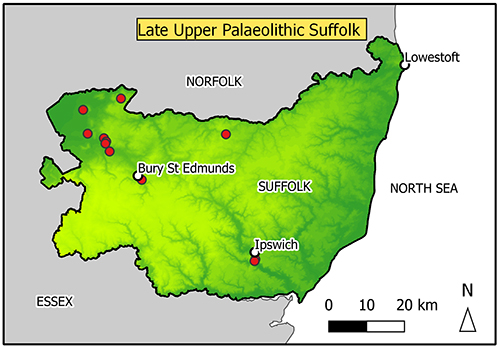
Image: Late Palaeolithic Findspots in Suffolk
The Final Palaeolithic period in Britain spans from c. 12,000 – 10,800BC The flint assemblages were characterised by examples of backed blades, curved backed blades and “penknife points”. This flint technology is very similar to the federmessergruppe tool assemblage type in Germany. Much of southern Britain was covered in woodland which supported fauna including red deer, roe deer, elk and aurochs; it can be assumed that these species were hunted, perhaps utilising bow and arrow technology with the penknife points used as arrowheads. These assemblages were present in the Allerød period when the temperatures were warmer. These flint types disappeared at the onset of the Younger Dryas cold period c. 10,800-9700BC Britain was apparently abandoned.
The map below shows the distribution of Final Palaeolithic finds in Suffolk. There are only a few and are almost exclusively found in the Gipping valley near Ipswich and in the Breckland and Fen Edge areas in the North West of the county. There is a single find from the Waveney Valley near Bungay.
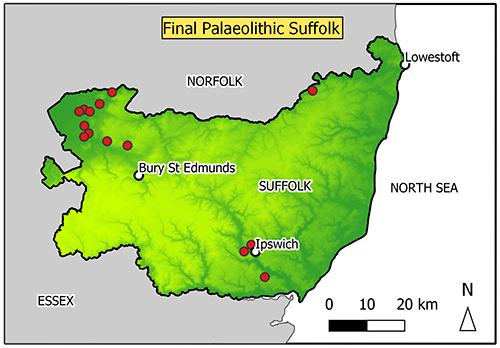
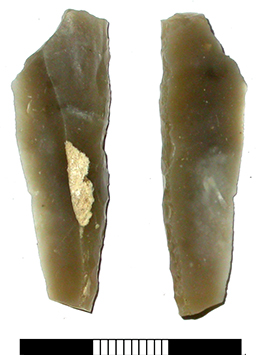
Image (left): Final Palaeolithic Findspots in Suffolk. Image (right): Penknife Point from Berkshire
The Terminal Palaeolithic is at the very end of the Palaeolithic period spanning from c.9,700 to 9,400BC.
It is considered to related to the Ahrensbergian technocomplex, which is present in mainland Europe and is associated with the hunting of large reindeer herds at specific points in their yearly annual migrations in Tundra conditions.
In Britain, the Terminal Palaeolithic is most readily identified by long flint blades >120mm in length made from large opposed platform cores and bruised pieces – flakes and blades with heavy edge damage. Important sites with large assemblages in Suffolk include Devils Wood Pit in Sproughton near Ipswich (SPT 001), The Kings Site in Mildenhall (MNL 005) and Brandon (BRD 248, BRD 018).
The map below shows the distribution of Terminal Palaeolithic finds. There is a concentration in the Breckland and Fen Edge area and around Ipswich, with most other finds along the larger river valleys.
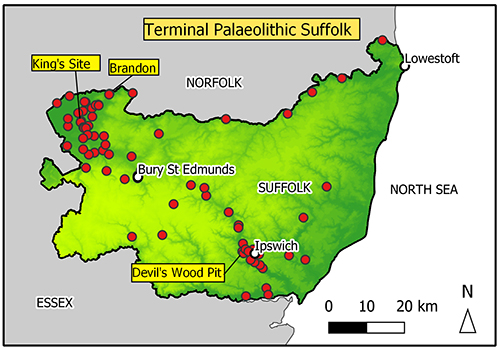
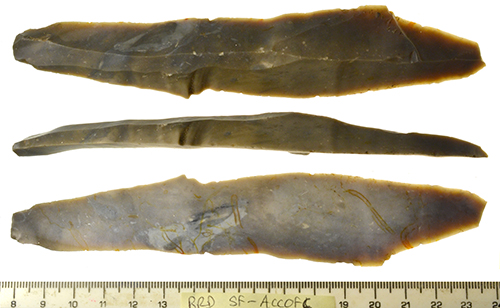
Image: (left) Terminal Palaeolithic Sites and Findspots in Suffolk. Image (right): A Long Blade from Brandon, HER record BRD 248
This project was kindly funded by Historic England.

